ACCT20075 Auditing and Ethics: Cleanaway Waste Management Report 2017
VerifiedAdded on 2023/06/07
|13
|3335
|90
Report
AI Summary
This report provides an in-depth analysis of Cleanaway Waste Management's 2017 annual report, focusing on the level of materiality for the audit of the company’s financial statements. It includes a preliminary analytical review of the company's financial information, addressing key balance sheet and profit and loss ratios from 2014 to 2017. The report reviews the company's cash flow statement, discussing primary cash receipts and payments during the year ending 2017. It also examines draft notes and disclosures, highlighting critical accounting estimates and their potential impact on the financial statements. Furthermore, the analysis covers relevant assertions and audit procedures, ensuring the accuracy and completeness of the financial records.
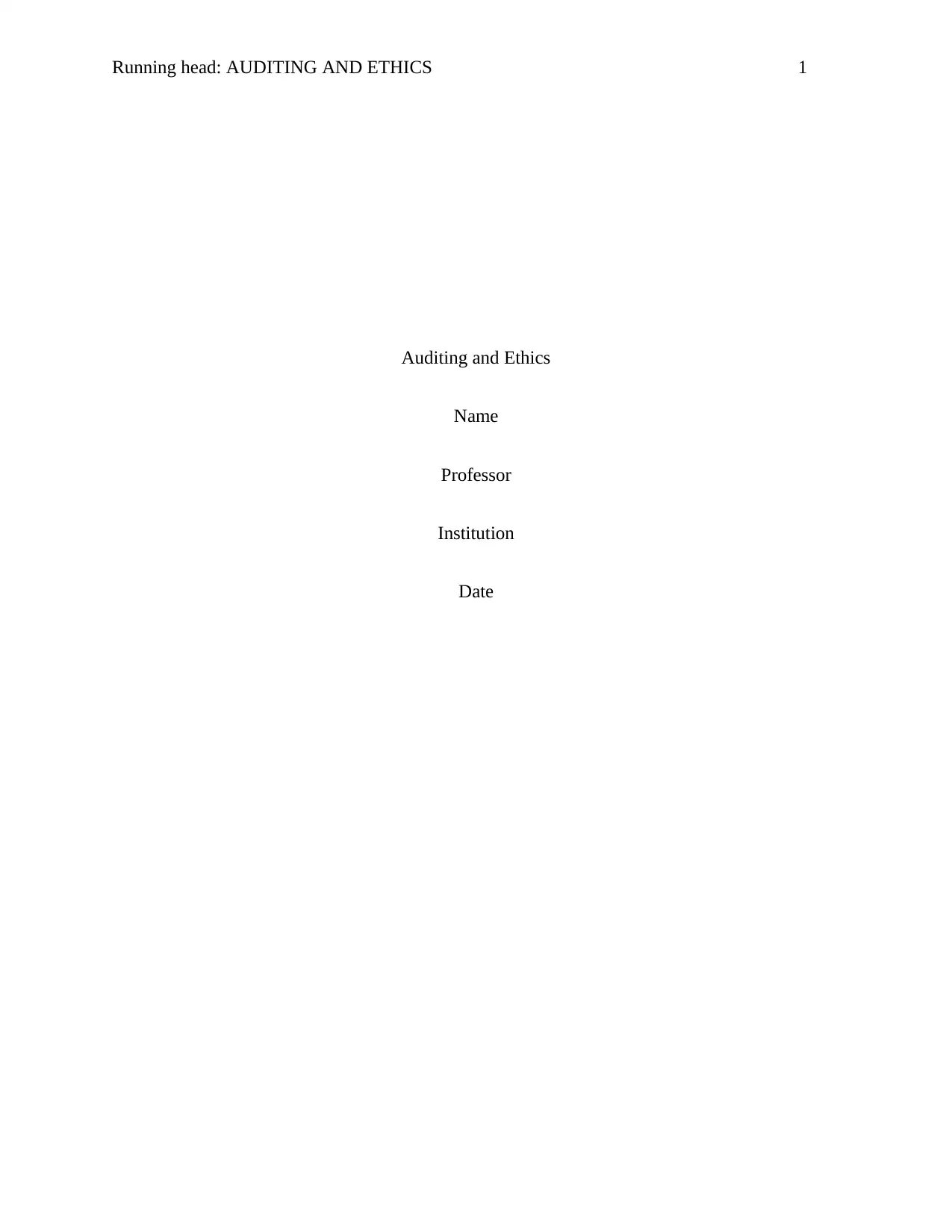
Running head: AUDITING AND ETHICS 1
Auditing and Ethics
Name
Professor
Institution
Date
Auditing and Ethics
Name
Professor
Institution
Date
Paraphrase This Document
Need a fresh take? Get an instant paraphrase of this document with our AI Paraphraser
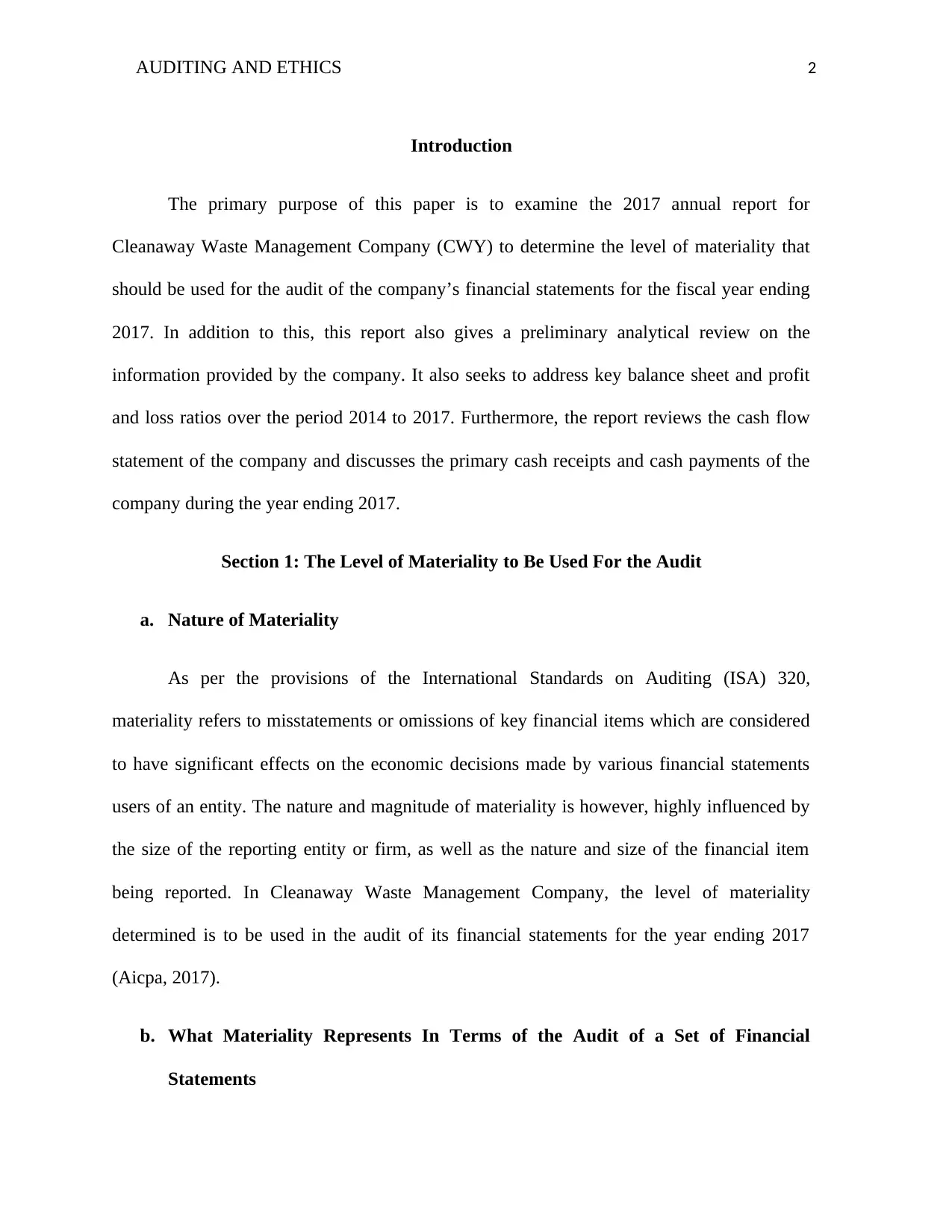
AUDITING AND ETHICS 2
Introduction
The primary purpose of this paper is to examine the 2017 annual report for
Cleanaway Waste Management Company (CWY) to determine the level of materiality that
should be used for the audit of the company’s financial statements for the fiscal year ending
2017. In addition to this, this report also gives a preliminary analytical review on the
information provided by the company. It also seeks to address key balance sheet and profit
and loss ratios over the period 2014 to 2017. Furthermore, the report reviews the cash flow
statement of the company and discusses the primary cash receipts and cash payments of the
company during the year ending 2017.
Section 1: The Level of Materiality to Be Used For the Audit
a. Nature of Materiality
As per the provisions of the International Standards on Auditing (ISA) 320,
materiality refers to misstatements or omissions of key financial items which are considered
to have significant effects on the economic decisions made by various financial statements
users of an entity. The nature and magnitude of materiality is however, highly influenced by
the size of the reporting entity or firm, as well as the nature and size of the financial item
being reported. In Cleanaway Waste Management Company, the level of materiality
determined is to be used in the audit of its financial statements for the year ending 2017
(Aicpa, 2017).
b. What Materiality Represents In Terms of the Audit of a Set of Financial
Statements
Introduction
The primary purpose of this paper is to examine the 2017 annual report for
Cleanaway Waste Management Company (CWY) to determine the level of materiality that
should be used for the audit of the company’s financial statements for the fiscal year ending
2017. In addition to this, this report also gives a preliminary analytical review on the
information provided by the company. It also seeks to address key balance sheet and profit
and loss ratios over the period 2014 to 2017. Furthermore, the report reviews the cash flow
statement of the company and discusses the primary cash receipts and cash payments of the
company during the year ending 2017.
Section 1: The Level of Materiality to Be Used For the Audit
a. Nature of Materiality
As per the provisions of the International Standards on Auditing (ISA) 320,
materiality refers to misstatements or omissions of key financial items which are considered
to have significant effects on the economic decisions made by various financial statements
users of an entity. The nature and magnitude of materiality is however, highly influenced by
the size of the reporting entity or firm, as well as the nature and size of the financial item
being reported. In Cleanaway Waste Management Company, the level of materiality
determined is to be used in the audit of its financial statements for the year ending 2017
(Aicpa, 2017).
b. What Materiality Represents In Terms of the Audit of a Set of Financial
Statements
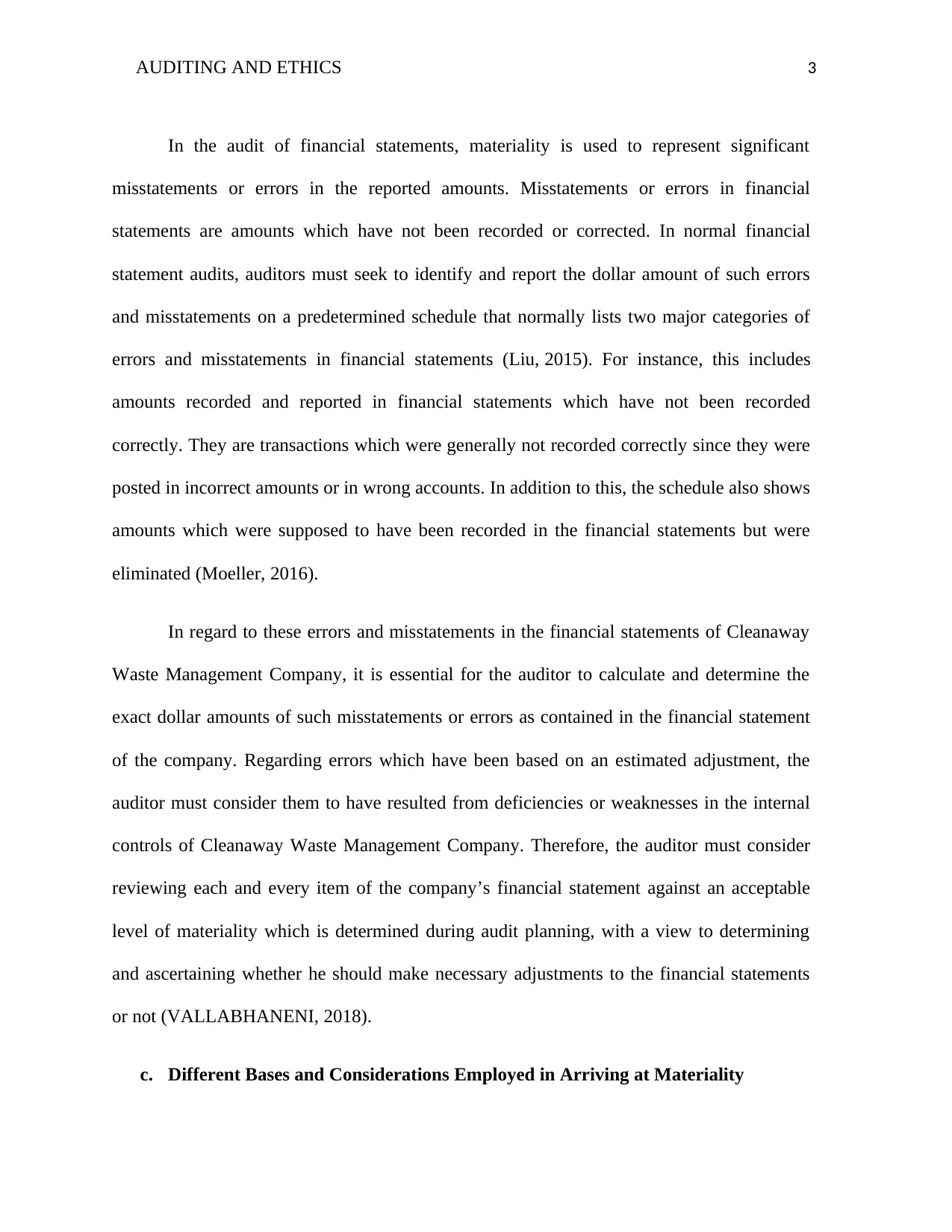
AUDITING AND ETHICS 3
In the audit of financial statements, materiality is used to represent significant
misstatements or errors in the reported amounts. Misstatements or errors in financial
statements are amounts which have not been recorded or corrected. In normal financial
statement audits, auditors must seek to identify and report the dollar amount of such errors
and misstatements on a predetermined schedule that normally lists two major categories of
errors and misstatements in financial statements (Liu, 2015). For instance, this includes
amounts recorded and reported in financial statements which have not been recorded
correctly. They are transactions which were generally not recorded correctly since they were
posted in incorrect amounts or in wrong accounts. In addition to this, the schedule also shows
amounts which were supposed to have been recorded in the financial statements but were
eliminated (Moeller, 2016).
In regard to these errors and misstatements in the financial statements of Cleanaway
Waste Management Company, it is essential for the auditor to calculate and determine the
exact dollar amounts of such misstatements or errors as contained in the financial statement
of the company. Regarding errors which have been based on an estimated adjustment, the
auditor must consider them to have resulted from deficiencies or weaknesses in the internal
controls of Cleanaway Waste Management Company. Therefore, the auditor must consider
reviewing each and every item of the company’s financial statement against an acceptable
level of materiality which is determined during audit planning, with a view to determining
and ascertaining whether he should make necessary adjustments to the financial statements
or not (VALLABHANENI, 2018).
c. Different Bases and Considerations Employed in Arriving at Materiality
In the audit of financial statements, materiality is used to represent significant
misstatements or errors in the reported amounts. Misstatements or errors in financial
statements are amounts which have not been recorded or corrected. In normal financial
statement audits, auditors must seek to identify and report the dollar amount of such errors
and misstatements on a predetermined schedule that normally lists two major categories of
errors and misstatements in financial statements (Liu, 2015). For instance, this includes
amounts recorded and reported in financial statements which have not been recorded
correctly. They are transactions which were generally not recorded correctly since they were
posted in incorrect amounts or in wrong accounts. In addition to this, the schedule also shows
amounts which were supposed to have been recorded in the financial statements but were
eliminated (Moeller, 2016).
In regard to these errors and misstatements in the financial statements of Cleanaway
Waste Management Company, it is essential for the auditor to calculate and determine the
exact dollar amounts of such misstatements or errors as contained in the financial statement
of the company. Regarding errors which have been based on an estimated adjustment, the
auditor must consider them to have resulted from deficiencies or weaknesses in the internal
controls of Cleanaway Waste Management Company. Therefore, the auditor must consider
reviewing each and every item of the company’s financial statement against an acceptable
level of materiality which is determined during audit planning, with a view to determining
and ascertaining whether he should make necessary adjustments to the financial statements
or not (VALLABHANENI, 2018).
c. Different Bases and Considerations Employed in Arriving at Materiality
⊘ This is a preview!⊘
Do you want full access?
Subscribe today to unlock all pages.

Trusted by 1+ million students worldwide
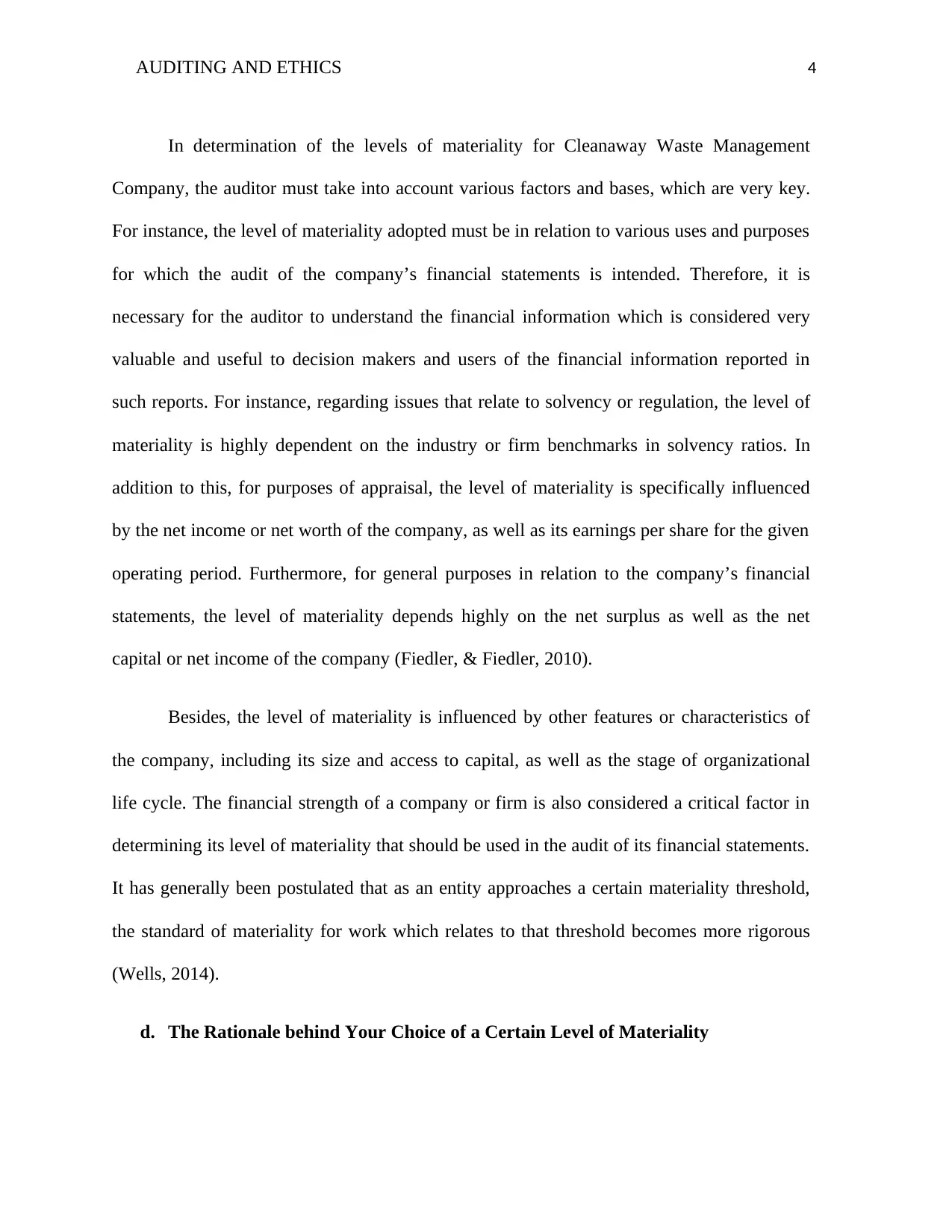
AUDITING AND ETHICS 4
In determination of the levels of materiality for Cleanaway Waste Management
Company, the auditor must take into account various factors and bases, which are very key.
For instance, the level of materiality adopted must be in relation to various uses and purposes
for which the audit of the company’s financial statements is intended. Therefore, it is
necessary for the auditor to understand the financial information which is considered very
valuable and useful to decision makers and users of the financial information reported in
such reports. For instance, regarding issues that relate to solvency or regulation, the level of
materiality is highly dependent on the industry or firm benchmarks in solvency ratios. In
addition to this, for purposes of appraisal, the level of materiality is specifically influenced
by the net income or net worth of the company, as well as its earnings per share for the given
operating period. Furthermore, for general purposes in relation to the company’s financial
statements, the level of materiality depends highly on the net surplus as well as the net
capital or net income of the company (Fiedler, & Fiedler, 2010).
Besides, the level of materiality is influenced by other features or characteristics of
the company, including its size and access to capital, as well as the stage of organizational
life cycle. The financial strength of a company or firm is also considered a critical factor in
determining its level of materiality that should be used in the audit of its financial statements.
It has generally been postulated that as an entity approaches a certain materiality threshold,
the standard of materiality for work which relates to that threshold becomes more rigorous
(Wells, 2014).
d. The Rationale behind Your Choice of a Certain Level of Materiality
In determination of the levels of materiality for Cleanaway Waste Management
Company, the auditor must take into account various factors and bases, which are very key.
For instance, the level of materiality adopted must be in relation to various uses and purposes
for which the audit of the company’s financial statements is intended. Therefore, it is
necessary for the auditor to understand the financial information which is considered very
valuable and useful to decision makers and users of the financial information reported in
such reports. For instance, regarding issues that relate to solvency or regulation, the level of
materiality is highly dependent on the industry or firm benchmarks in solvency ratios. In
addition to this, for purposes of appraisal, the level of materiality is specifically influenced
by the net income or net worth of the company, as well as its earnings per share for the given
operating period. Furthermore, for general purposes in relation to the company’s financial
statements, the level of materiality depends highly on the net surplus as well as the net
capital or net income of the company (Fiedler, & Fiedler, 2010).
Besides, the level of materiality is influenced by other features or characteristics of
the company, including its size and access to capital, as well as the stage of organizational
life cycle. The financial strength of a company or firm is also considered a critical factor in
determining its level of materiality that should be used in the audit of its financial statements.
It has generally been postulated that as an entity approaches a certain materiality threshold,
the standard of materiality for work which relates to that threshold becomes more rigorous
(Wells, 2014).
d. The Rationale behind Your Choice of a Certain Level of Materiality
Paraphrase This Document
Need a fresh take? Get an instant paraphrase of this document with our AI Paraphraser
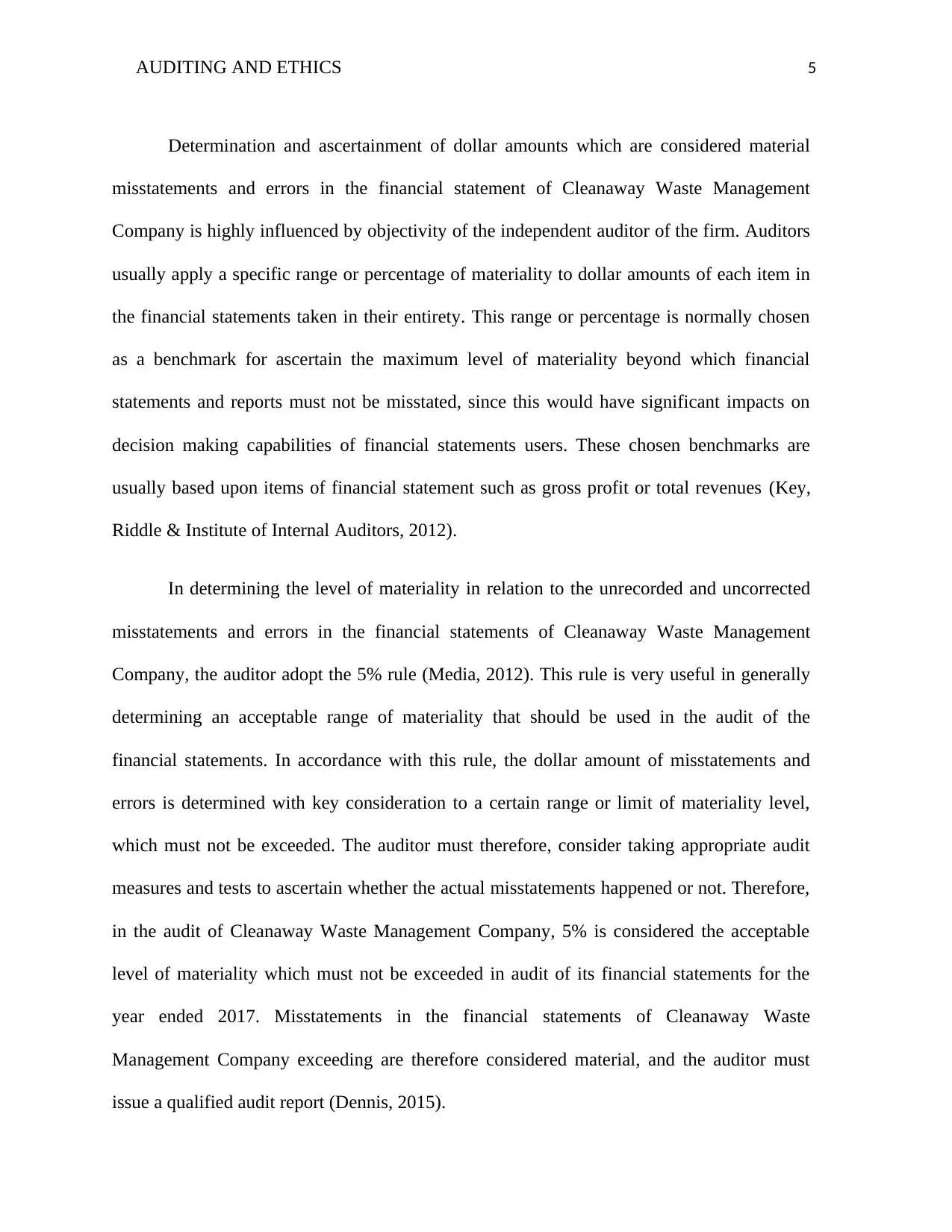
AUDITING AND ETHICS 5
Determination and ascertainment of dollar amounts which are considered material
misstatements and errors in the financial statement of Cleanaway Waste Management
Company is highly influenced by objectivity of the independent auditor of the firm. Auditors
usually apply a specific range or percentage of materiality to dollar amounts of each item in
the financial statements taken in their entirety. This range or percentage is normally chosen
as a benchmark for ascertain the maximum level of materiality beyond which financial
statements and reports must not be misstated, since this would have significant impacts on
decision making capabilities of financial statements users. These chosen benchmarks are
usually based upon items of financial statement such as gross profit or total revenues (Key,
Riddle & Institute of Internal Auditors, 2012).
In determining the level of materiality in relation to the unrecorded and uncorrected
misstatements and errors in the financial statements of Cleanaway Waste Management
Company, the auditor adopt the 5% rule (Media, 2012). This rule is very useful in generally
determining an acceptable range of materiality that should be used in the audit of the
financial statements. In accordance with this rule, the dollar amount of misstatements and
errors is determined with key consideration to a certain range or limit of materiality level,
which must not be exceeded. The auditor must therefore, consider taking appropriate audit
measures and tests to ascertain whether the actual misstatements happened or not. Therefore,
in the audit of Cleanaway Waste Management Company, 5% is considered the acceptable
level of materiality which must not be exceeded in audit of its financial statements for the
year ended 2017. Misstatements in the financial statements of Cleanaway Waste
Management Company exceeding are therefore considered material, and the auditor must
issue a qualified audit report (Dennis, 2015).
Determination and ascertainment of dollar amounts which are considered material
misstatements and errors in the financial statement of Cleanaway Waste Management
Company is highly influenced by objectivity of the independent auditor of the firm. Auditors
usually apply a specific range or percentage of materiality to dollar amounts of each item in
the financial statements taken in their entirety. This range or percentage is normally chosen
as a benchmark for ascertain the maximum level of materiality beyond which financial
statements and reports must not be misstated, since this would have significant impacts on
decision making capabilities of financial statements users. These chosen benchmarks are
usually based upon items of financial statement such as gross profit or total revenues (Key,
Riddle & Institute of Internal Auditors, 2012).
In determining the level of materiality in relation to the unrecorded and uncorrected
misstatements and errors in the financial statements of Cleanaway Waste Management
Company, the auditor adopt the 5% rule (Media, 2012). This rule is very useful in generally
determining an acceptable range of materiality that should be used in the audit of the
financial statements. In accordance with this rule, the dollar amount of misstatements and
errors is determined with key consideration to a certain range or limit of materiality level,
which must not be exceeded. The auditor must therefore, consider taking appropriate audit
measures and tests to ascertain whether the actual misstatements happened or not. Therefore,
in the audit of Cleanaway Waste Management Company, 5% is considered the acceptable
level of materiality which must not be exceeded in audit of its financial statements for the
year ended 2017. Misstatements in the financial statements of Cleanaway Waste
Management Company exceeding are therefore considered material, and the auditor must
issue a qualified audit report (Dennis, 2015).
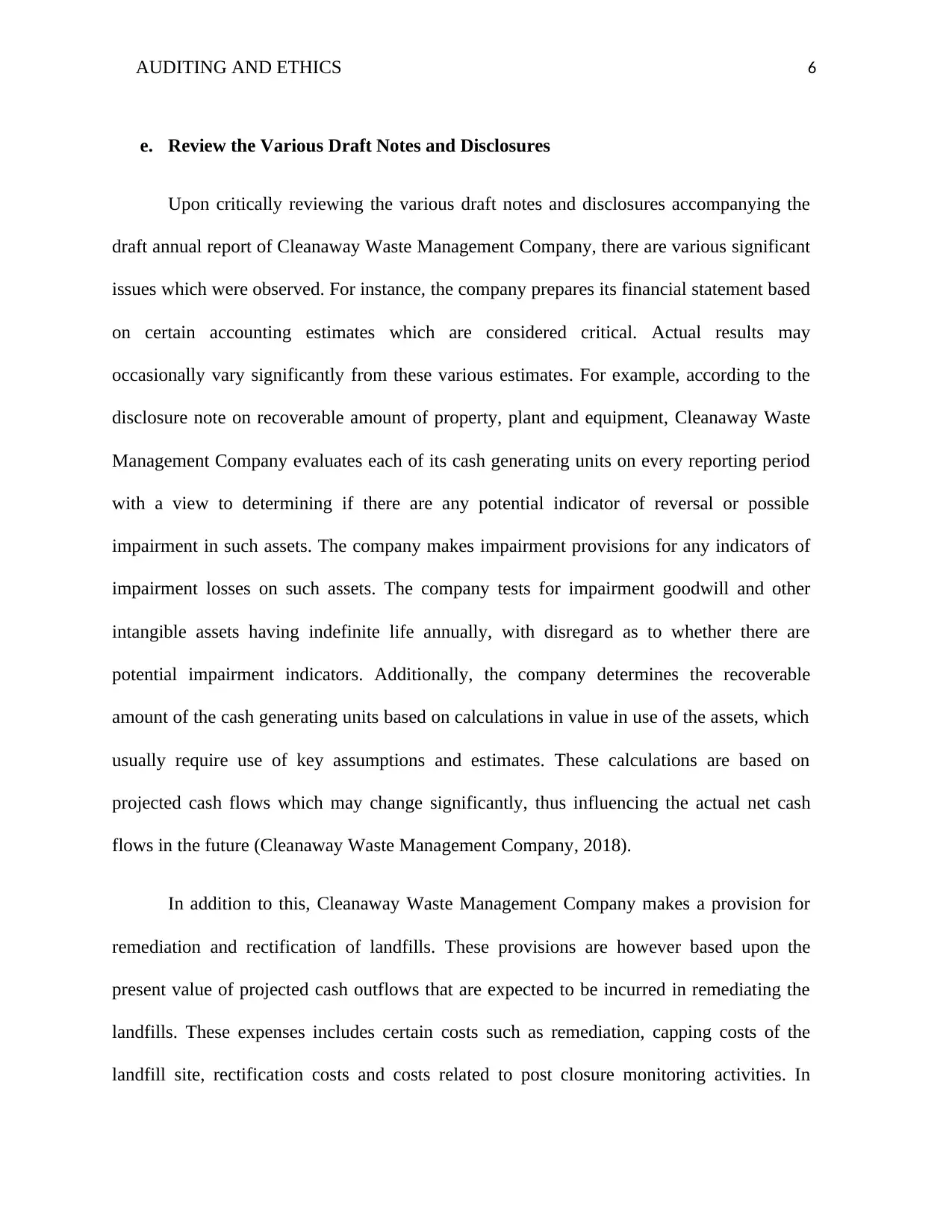
AUDITING AND ETHICS 6
e. Review the Various Draft Notes and Disclosures
Upon critically reviewing the various draft notes and disclosures accompanying the
draft annual report of Cleanaway Waste Management Company, there are various significant
issues which were observed. For instance, the company prepares its financial statement based
on certain accounting estimates which are considered critical. Actual results may
occasionally vary significantly from these various estimates. For example, according to the
disclosure note on recoverable amount of property, plant and equipment, Cleanaway Waste
Management Company evaluates each of its cash generating units on every reporting period
with a view to determining if there are any potential indicator of reversal or possible
impairment in such assets. The company makes impairment provisions for any indicators of
impairment losses on such assets. The company tests for impairment goodwill and other
intangible assets having indefinite life annually, with disregard as to whether there are
potential impairment indicators. Additionally, the company determines the recoverable
amount of the cash generating units based on calculations in value in use of the assets, which
usually require use of key assumptions and estimates. These calculations are based on
projected cash flows which may change significantly, thus influencing the actual net cash
flows in the future (Cleanaway Waste Management Company, 2018).
In addition to this, Cleanaway Waste Management Company makes a provision for
remediation and rectification of landfills. These provisions are however based upon the
present value of projected cash outflows that are expected to be incurred in remediating the
landfills. These expenses includes certain costs such as remediation, capping costs of the
landfill site, rectification costs and costs related to post closure monitoring activities. In
e. Review the Various Draft Notes and Disclosures
Upon critically reviewing the various draft notes and disclosures accompanying the
draft annual report of Cleanaway Waste Management Company, there are various significant
issues which were observed. For instance, the company prepares its financial statement based
on certain accounting estimates which are considered critical. Actual results may
occasionally vary significantly from these various estimates. For example, according to the
disclosure note on recoverable amount of property, plant and equipment, Cleanaway Waste
Management Company evaluates each of its cash generating units on every reporting period
with a view to determining if there are any potential indicator of reversal or possible
impairment in such assets. The company makes impairment provisions for any indicators of
impairment losses on such assets. The company tests for impairment goodwill and other
intangible assets having indefinite life annually, with disregard as to whether there are
potential impairment indicators. Additionally, the company determines the recoverable
amount of the cash generating units based on calculations in value in use of the assets, which
usually require use of key assumptions and estimates. These calculations are based on
projected cash flows which may change significantly, thus influencing the actual net cash
flows in the future (Cleanaway Waste Management Company, 2018).
In addition to this, Cleanaway Waste Management Company makes a provision for
remediation and rectification of landfills. These provisions are however based upon the
present value of projected cash outflows that are expected to be incurred in remediating the
landfills. These expenses includes certain costs such as remediation, capping costs of the
landfill site, rectification costs and costs related to post closure monitoring activities. In
⊘ This is a preview!⊘
Do you want full access?
Subscribe today to unlock all pages.

Trusted by 1+ million students worldwide
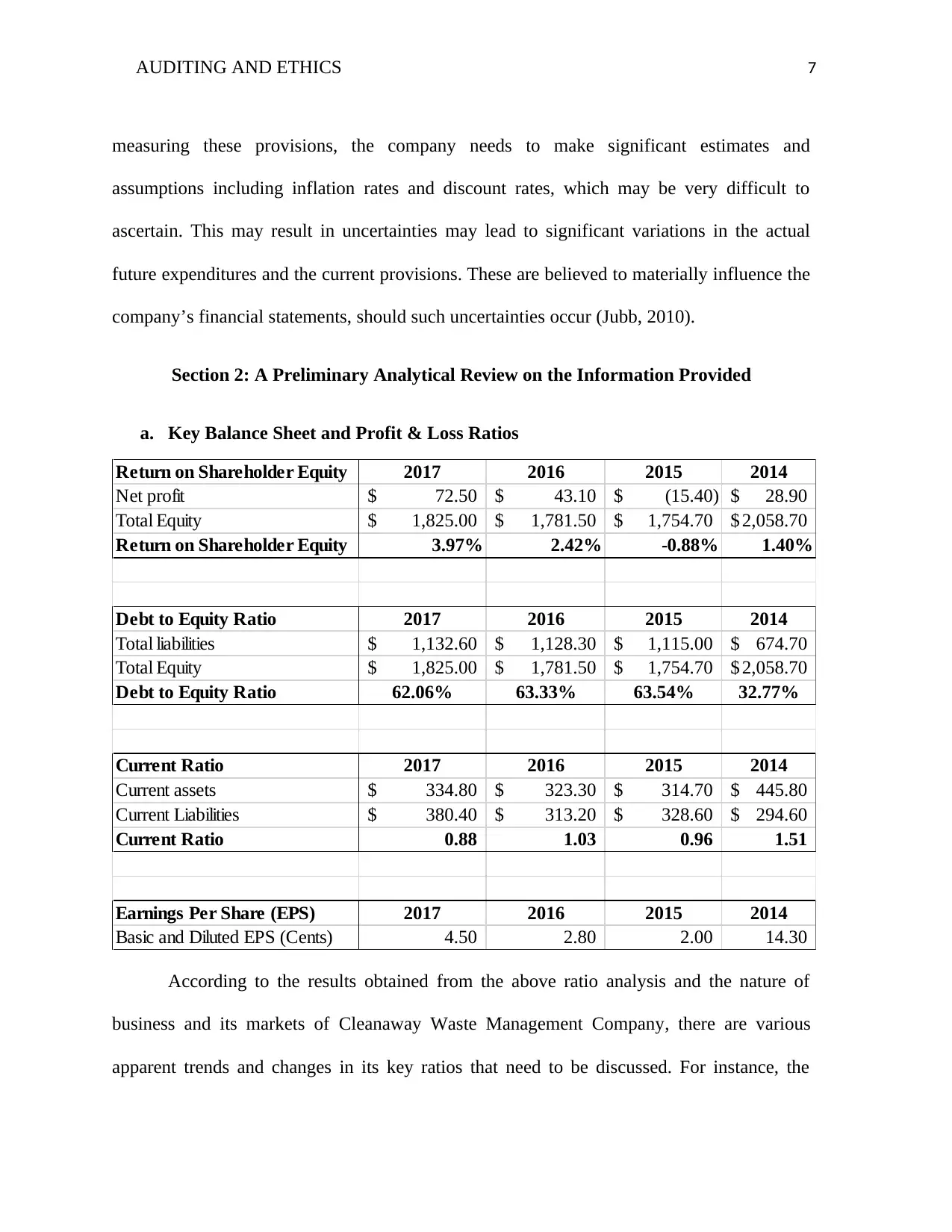
AUDITING AND ETHICS 7
measuring these provisions, the company needs to make significant estimates and
assumptions including inflation rates and discount rates, which may be very difficult to
ascertain. This may result in uncertainties may lead to significant variations in the actual
future expenditures and the current provisions. These are believed to materially influence the
company’s financial statements, should such uncertainties occur (Jubb, 2010).
Section 2: A Preliminary Analytical Review on the Information Provided
a. Key Balance Sheet and Profit & Loss Ratios
Return on Shareholder Equity 2017 2016 2015 2014
Net profit 72.50$ 43.10$ (15.40)$ 28.90$
Total Equity 1,825.00$ 1,781.50$ 1,754.70$ 2,058.70$
Return on Shareholder Equity 3.97% 2.42% -0.88% 1.40%
Debt to Equity Ratio 2017 2016 2015 2014
Total liabilities 1,132.60$ 1,128.30$ 1,115.00$ 674.70$
Total Equity 1,825.00$ 1,781.50$ 1,754.70$ 2,058.70$
Debt to Equity Ratio 62.06% 63.33% 63.54% 32.77%
Current Ratio 2017 2016 2015 2014
Current assets 334.80$ 323.30$ 314.70$ 445.80$
Current Liabilities 380.40$ 313.20$ 328.60$ 294.60$
Current Ratio 0.88 1.03 0.96 1.51
Earnings Per Share (EPS) 2017 2016 2015 2014
Basic and Diluted EPS (Cents) 4.50 2.80 2.00 14.30
According to the results obtained from the above ratio analysis and the nature of
business and its markets of Cleanaway Waste Management Company, there are various
apparent trends and changes in its key ratios that need to be discussed. For instance, the
measuring these provisions, the company needs to make significant estimates and
assumptions including inflation rates and discount rates, which may be very difficult to
ascertain. This may result in uncertainties may lead to significant variations in the actual
future expenditures and the current provisions. These are believed to materially influence the
company’s financial statements, should such uncertainties occur (Jubb, 2010).
Section 2: A Preliminary Analytical Review on the Information Provided
a. Key Balance Sheet and Profit & Loss Ratios
Return on Shareholder Equity 2017 2016 2015 2014
Net profit 72.50$ 43.10$ (15.40)$ 28.90$
Total Equity 1,825.00$ 1,781.50$ 1,754.70$ 2,058.70$
Return on Shareholder Equity 3.97% 2.42% -0.88% 1.40%
Debt to Equity Ratio 2017 2016 2015 2014
Total liabilities 1,132.60$ 1,128.30$ 1,115.00$ 674.70$
Total Equity 1,825.00$ 1,781.50$ 1,754.70$ 2,058.70$
Debt to Equity Ratio 62.06% 63.33% 63.54% 32.77%
Current Ratio 2017 2016 2015 2014
Current assets 334.80$ 323.30$ 314.70$ 445.80$
Current Liabilities 380.40$ 313.20$ 328.60$ 294.60$
Current Ratio 0.88 1.03 0.96 1.51
Earnings Per Share (EPS) 2017 2016 2015 2014
Basic and Diluted EPS (Cents) 4.50 2.80 2.00 14.30
According to the results obtained from the above ratio analysis and the nature of
business and its markets of Cleanaway Waste Management Company, there are various
apparent trends and changes in its key ratios that need to be discussed. For instance, the
Paraphrase This Document
Need a fresh take? Get an instant paraphrase of this document with our AI Paraphraser
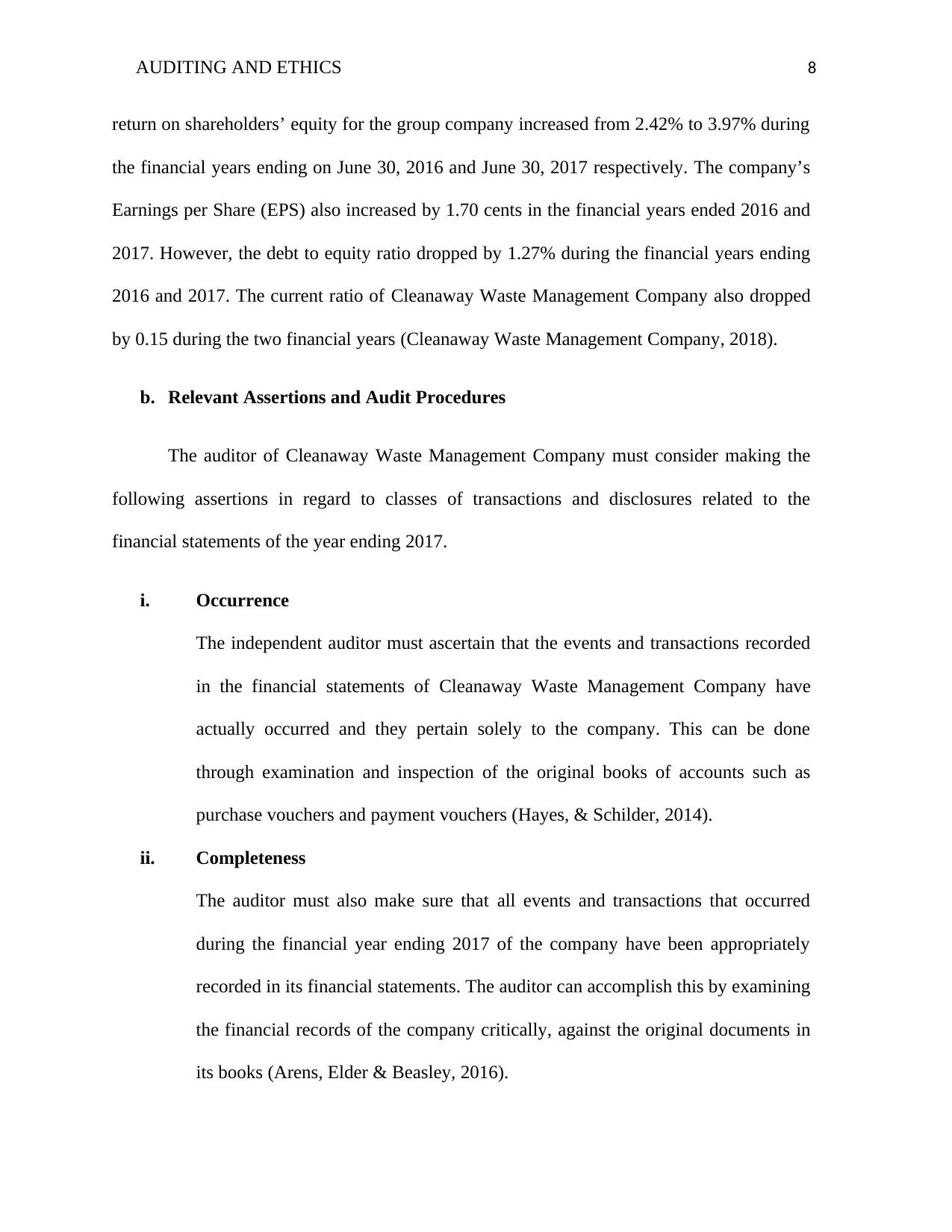
AUDITING AND ETHICS 8
return on shareholders’ equity for the group company increased from 2.42% to 3.97% during
the financial years ending on June 30, 2016 and June 30, 2017 respectively. The company’s
Earnings per Share (EPS) also increased by 1.70 cents in the financial years ended 2016 and
2017. However, the debt to equity ratio dropped by 1.27% during the financial years ending
2016 and 2017. The current ratio of Cleanaway Waste Management Company also dropped
by 0.15 during the two financial years (Cleanaway Waste Management Company, 2018).
b. Relevant Assertions and Audit Procedures
The auditor of Cleanaway Waste Management Company must consider making the
following assertions in regard to classes of transactions and disclosures related to the
financial statements of the year ending 2017.
i. Occurrence
The independent auditor must ascertain that the events and transactions recorded
in the financial statements of Cleanaway Waste Management Company have
actually occurred and they pertain solely to the company. This can be done
through examination and inspection of the original books of accounts such as
purchase vouchers and payment vouchers (Hayes, & Schilder, 2014).
ii. Completeness
The auditor must also make sure that all events and transactions that occurred
during the financial year ending 2017 of the company have been appropriately
recorded in its financial statements. The auditor can accomplish this by examining
the financial records of the company critically, against the original documents in
its books (Arens, Elder & Beasley, 2016).
return on shareholders’ equity for the group company increased from 2.42% to 3.97% during
the financial years ending on June 30, 2016 and June 30, 2017 respectively. The company’s
Earnings per Share (EPS) also increased by 1.70 cents in the financial years ended 2016 and
2017. However, the debt to equity ratio dropped by 1.27% during the financial years ending
2016 and 2017. The current ratio of Cleanaway Waste Management Company also dropped
by 0.15 during the two financial years (Cleanaway Waste Management Company, 2018).
b. Relevant Assertions and Audit Procedures
The auditor of Cleanaway Waste Management Company must consider making the
following assertions in regard to classes of transactions and disclosures related to the
financial statements of the year ending 2017.
i. Occurrence
The independent auditor must ascertain that the events and transactions recorded
in the financial statements of Cleanaway Waste Management Company have
actually occurred and they pertain solely to the company. This can be done
through examination and inspection of the original books of accounts such as
purchase vouchers and payment vouchers (Hayes, & Schilder, 2014).
ii. Completeness
The auditor must also make sure that all events and transactions that occurred
during the financial year ending 2017 of the company have been appropriately
recorded in its financial statements. The auditor can accomplish this by examining
the financial records of the company critically, against the original documents in
its books (Arens, Elder & Beasley, 2016).
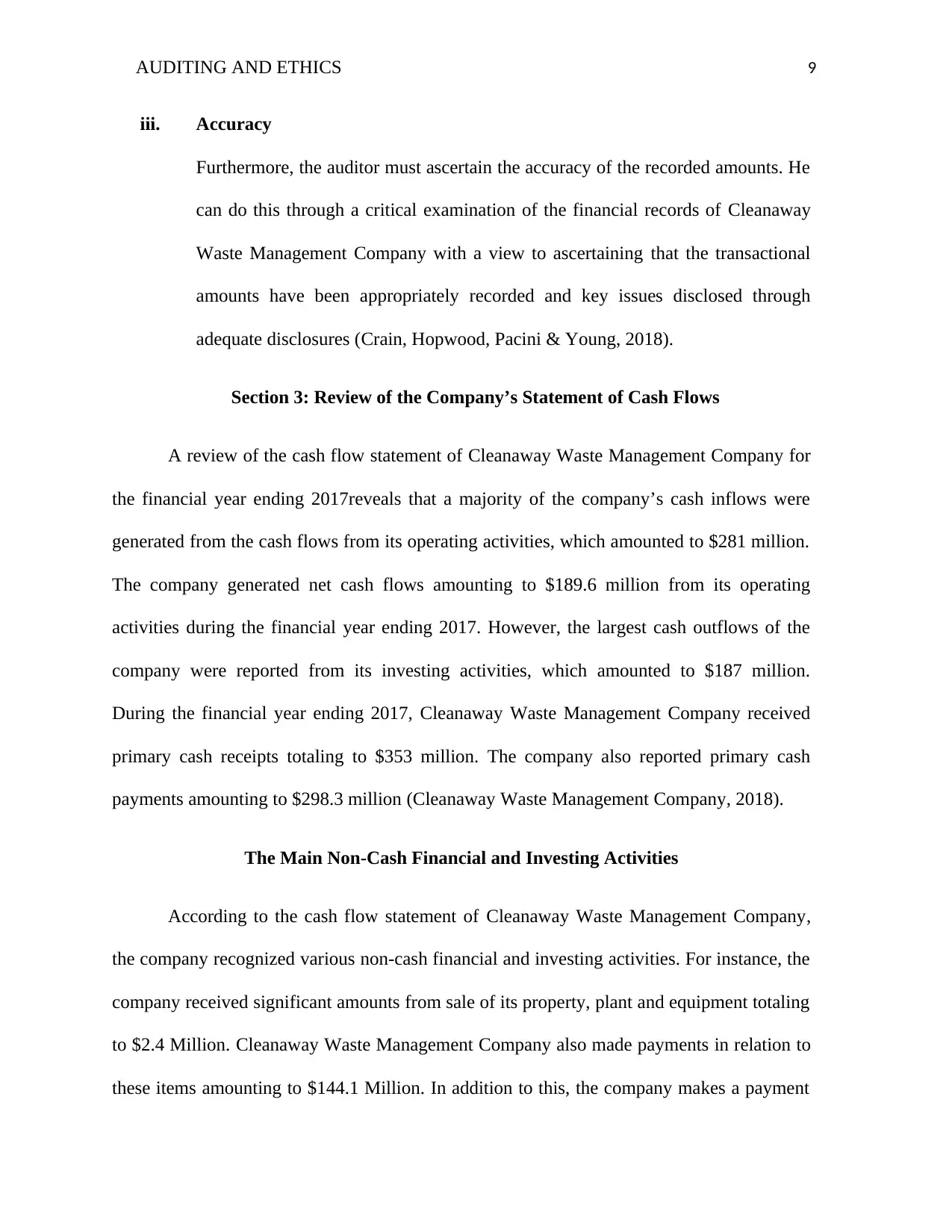
AUDITING AND ETHICS 9
iii. Accuracy
Furthermore, the auditor must ascertain the accuracy of the recorded amounts. He
can do this through a critical examination of the financial records of Cleanaway
Waste Management Company with a view to ascertaining that the transactional
amounts have been appropriately recorded and key issues disclosed through
adequate disclosures (Crain, Hopwood, Pacini & Young, 2018).
Section 3: Review of the Company’s Statement of Cash Flows
A review of the cash flow statement of Cleanaway Waste Management Company for
the financial year ending 2017reveals that a majority of the company’s cash inflows were
generated from the cash flows from its operating activities, which amounted to $281 million.
The company generated net cash flows amounting to $189.6 million from its operating
activities during the financial year ending 2017. However, the largest cash outflows of the
company were reported from its investing activities, which amounted to $187 million.
During the financial year ending 2017, Cleanaway Waste Management Company received
primary cash receipts totaling to $353 million. The company also reported primary cash
payments amounting to $298.3 million (Cleanaway Waste Management Company, 2018).
The Main Non-Cash Financial and Investing Activities
According to the cash flow statement of Cleanaway Waste Management Company,
the company recognized various non-cash financial and investing activities. For instance, the
company received significant amounts from sale of its property, plant and equipment totaling
to $2.4 Million. Cleanaway Waste Management Company also made payments in relation to
these items amounting to $144.1 Million. In addition to this, the company makes a payment
iii. Accuracy
Furthermore, the auditor must ascertain the accuracy of the recorded amounts. He
can do this through a critical examination of the financial records of Cleanaway
Waste Management Company with a view to ascertaining that the transactional
amounts have been appropriately recorded and key issues disclosed through
adequate disclosures (Crain, Hopwood, Pacini & Young, 2018).
Section 3: Review of the Company’s Statement of Cash Flows
A review of the cash flow statement of Cleanaway Waste Management Company for
the financial year ending 2017reveals that a majority of the company’s cash inflows were
generated from the cash flows from its operating activities, which amounted to $281 million.
The company generated net cash flows amounting to $189.6 million from its operating
activities during the financial year ending 2017. However, the largest cash outflows of the
company were reported from its investing activities, which amounted to $187 million.
During the financial year ending 2017, Cleanaway Waste Management Company received
primary cash receipts totaling to $353 million. The company also reported primary cash
payments amounting to $298.3 million (Cleanaway Waste Management Company, 2018).
The Main Non-Cash Financial and Investing Activities
According to the cash flow statement of Cleanaway Waste Management Company,
the company recognized various non-cash financial and investing activities. For instance, the
company received significant amounts from sale of its property, plant and equipment totaling
to $2.4 Million. Cleanaway Waste Management Company also made payments in relation to
these items amounting to $144.1 Million. In addition to this, the company makes a payment
⊘ This is a preview!⊘
Do you want full access?
Subscribe today to unlock all pages.

Trusted by 1+ million students worldwide
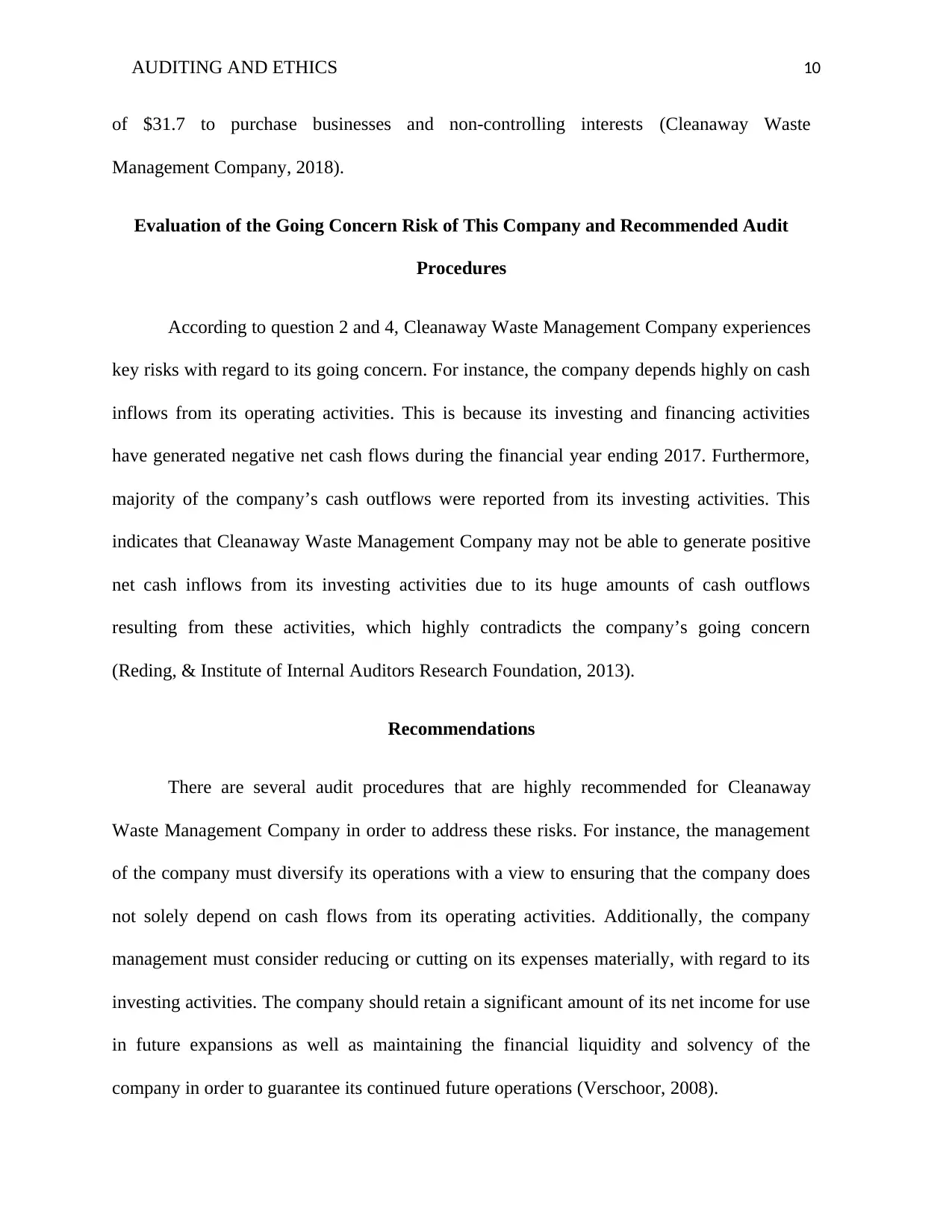
AUDITING AND ETHICS 10
of $31.7 to purchase businesses and non-controlling interests (Cleanaway Waste
Management Company, 2018).
Evaluation of the Going Concern Risk of This Company and Recommended Audit
Procedures
According to question 2 and 4, Cleanaway Waste Management Company experiences
key risks with regard to its going concern. For instance, the company depends highly on cash
inflows from its operating activities. This is because its investing and financing activities
have generated negative net cash flows during the financial year ending 2017. Furthermore,
majority of the company’s cash outflows were reported from its investing activities. This
indicates that Cleanaway Waste Management Company may not be able to generate positive
net cash inflows from its investing activities due to its huge amounts of cash outflows
resulting from these activities, which highly contradicts the company’s going concern
(Reding, & Institute of Internal Auditors Research Foundation, 2013).
Recommendations
There are several audit procedures that are highly recommended for Cleanaway
Waste Management Company in order to address these risks. For instance, the management
of the company must diversify its operations with a view to ensuring that the company does
not solely depend on cash flows from its operating activities. Additionally, the company
management must consider reducing or cutting on its expenses materially, with regard to its
investing activities. The company should retain a significant amount of its net income for use
in future expansions as well as maintaining the financial liquidity and solvency of the
company in order to guarantee its continued future operations (Verschoor, 2008).
of $31.7 to purchase businesses and non-controlling interests (Cleanaway Waste
Management Company, 2018).
Evaluation of the Going Concern Risk of This Company and Recommended Audit
Procedures
According to question 2 and 4, Cleanaway Waste Management Company experiences
key risks with regard to its going concern. For instance, the company depends highly on cash
inflows from its operating activities. This is because its investing and financing activities
have generated negative net cash flows during the financial year ending 2017. Furthermore,
majority of the company’s cash outflows were reported from its investing activities. This
indicates that Cleanaway Waste Management Company may not be able to generate positive
net cash inflows from its investing activities due to its huge amounts of cash outflows
resulting from these activities, which highly contradicts the company’s going concern
(Reding, & Institute of Internal Auditors Research Foundation, 2013).
Recommendations
There are several audit procedures that are highly recommended for Cleanaway
Waste Management Company in order to address these risks. For instance, the management
of the company must diversify its operations with a view to ensuring that the company does
not solely depend on cash flows from its operating activities. Additionally, the company
management must consider reducing or cutting on its expenses materially, with regard to its
investing activities. The company should retain a significant amount of its net income for use
in future expansions as well as maintaining the financial liquidity and solvency of the
company in order to guarantee its continued future operations (Verschoor, 2008).
Paraphrase This Document
Need a fresh take? Get an instant paraphrase of this document with our AI Paraphraser
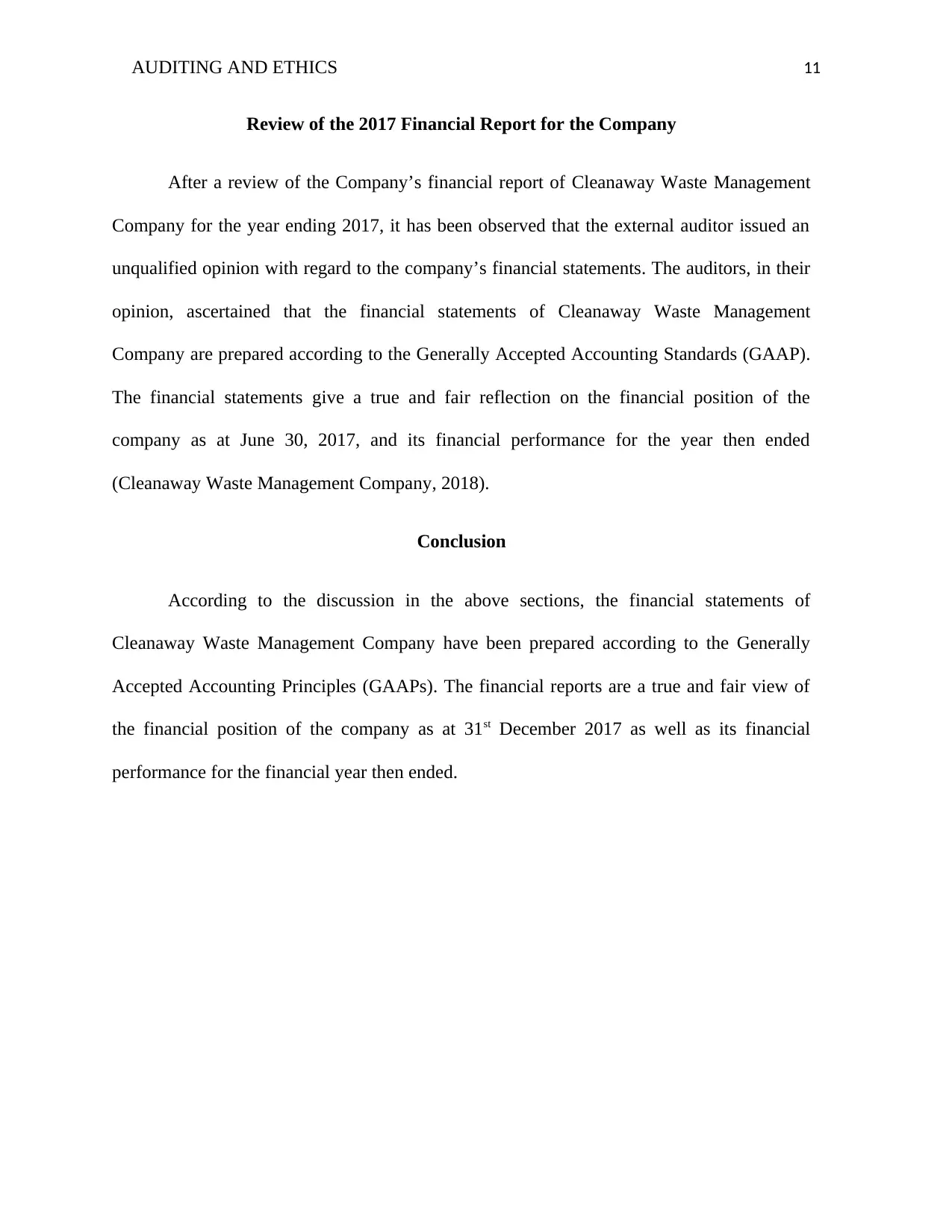
AUDITING AND ETHICS 11
Review of the 2017 Financial Report for the Company
After a review of the Company’s financial report of Cleanaway Waste Management
Company for the year ending 2017, it has been observed that the external auditor issued an
unqualified opinion with regard to the company’s financial statements. The auditors, in their
opinion, ascertained that the financial statements of Cleanaway Waste Management
Company are prepared according to the Generally Accepted Accounting Standards (GAAP).
The financial statements give a true and fair reflection on the financial position of the
company as at June 30, 2017, and its financial performance for the year then ended
(Cleanaway Waste Management Company, 2018).
Conclusion
According to the discussion in the above sections, the financial statements of
Cleanaway Waste Management Company have been prepared according to the Generally
Accepted Accounting Principles (GAAPs). The financial reports are a true and fair view of
the financial position of the company as at 31st December 2017 as well as its financial
performance for the financial year then ended.
Review of the 2017 Financial Report for the Company
After a review of the Company’s financial report of Cleanaway Waste Management
Company for the year ending 2017, it has been observed that the external auditor issued an
unqualified opinion with regard to the company’s financial statements. The auditors, in their
opinion, ascertained that the financial statements of Cleanaway Waste Management
Company are prepared according to the Generally Accepted Accounting Standards (GAAP).
The financial statements give a true and fair reflection on the financial position of the
company as at June 30, 2017, and its financial performance for the year then ended
(Cleanaway Waste Management Company, 2018).
Conclusion
According to the discussion in the above sections, the financial statements of
Cleanaway Waste Management Company have been prepared according to the Generally
Accepted Accounting Principles (GAAPs). The financial reports are a true and fair view of
the financial position of the company as at 31st December 2017 as well as its financial
performance for the financial year then ended.
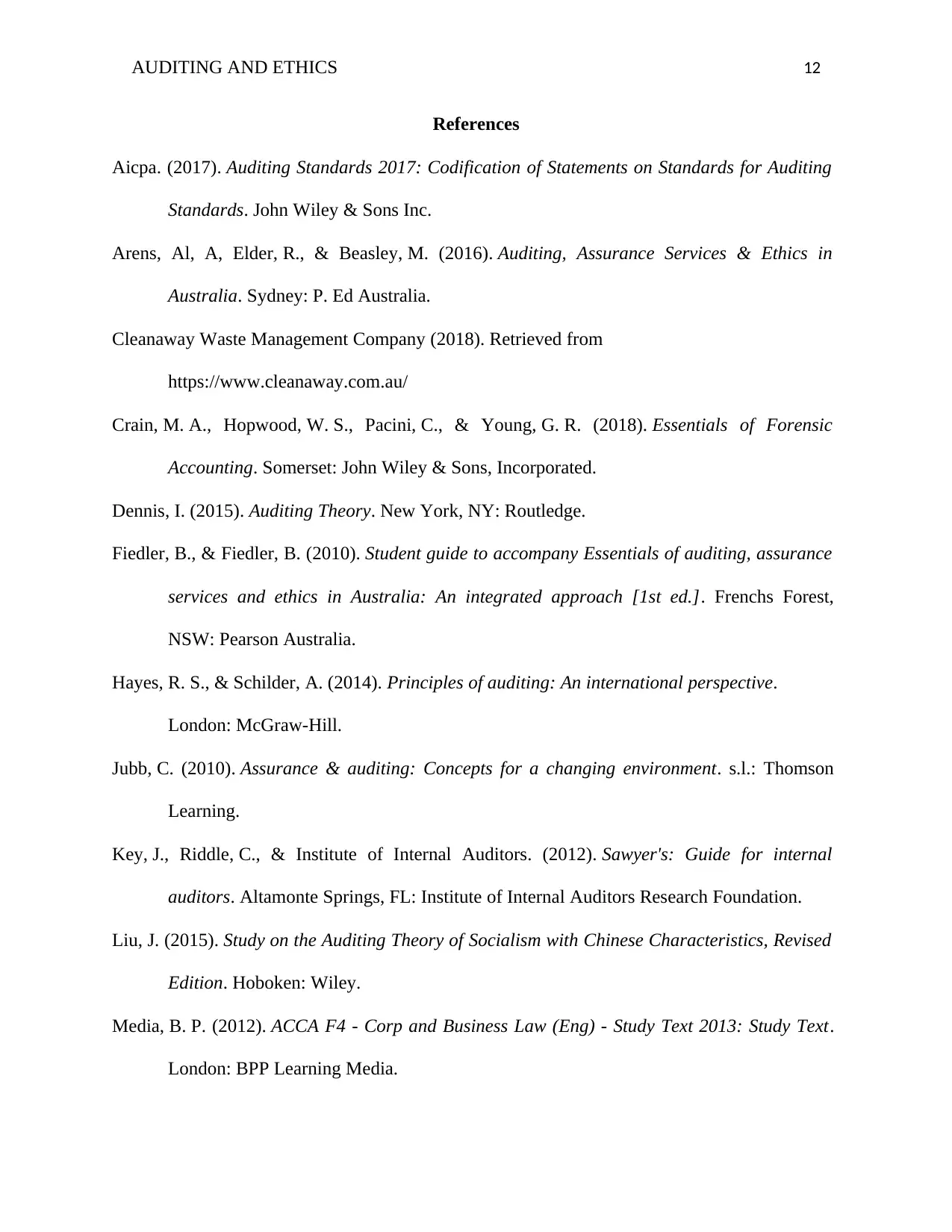
AUDITING AND ETHICS 12
References
Aicpa. (2017). Auditing Standards 2017: Codification of Statements on Standards for Auditing
Standards. John Wiley & Sons Inc.
Arens, Al, A, Elder, R., & Beasley, M. (2016). Auditing, Assurance Services & Ethics in
Australia. Sydney: P. Ed Australia.
Cleanaway Waste Management Company (2018). Retrieved from
https://www.cleanaway.com.au/
Crain, M. A., Hopwood, W. S., Pacini, C., & Young, G. R. (2018). Essentials of Forensic
Accounting. Somerset: John Wiley & Sons, Incorporated.
Dennis, I. (2015). Auditing Theory. New York, NY: Routledge.
Fiedler, B., & Fiedler, B. (2010). Student guide to accompany Essentials of auditing, assurance
services and ethics in Australia: An integrated approach [1st ed.]. Frenchs Forest,
NSW: Pearson Australia.
Hayes, R. S., & Schilder, A. (2014). Principles of auditing: An international perspective.
London: McGraw-Hill.
Jubb, C. (2010). Assurance & auditing: Concepts for a changing environment. s.l.: Thomson
Learning.
Key, J., Riddle, C., & Institute of Internal Auditors. (2012). Sawyer's: Guide for internal
auditors. Altamonte Springs, FL: Institute of Internal Auditors Research Foundation.
Liu, J. (2015). Study on the Auditing Theory of Socialism with Chinese Characteristics, Revised
Edition. Hoboken: Wiley.
Media, B. P. (2012). ACCA F4 - Corp and Business Law (Eng) - Study Text 2013: Study Text.
London: BPP Learning Media.
References
Aicpa. (2017). Auditing Standards 2017: Codification of Statements on Standards for Auditing
Standards. John Wiley & Sons Inc.
Arens, Al, A, Elder, R., & Beasley, M. (2016). Auditing, Assurance Services & Ethics in
Australia. Sydney: P. Ed Australia.
Cleanaway Waste Management Company (2018). Retrieved from
https://www.cleanaway.com.au/
Crain, M. A., Hopwood, W. S., Pacini, C., & Young, G. R. (2018). Essentials of Forensic
Accounting. Somerset: John Wiley & Sons, Incorporated.
Dennis, I. (2015). Auditing Theory. New York, NY: Routledge.
Fiedler, B., & Fiedler, B. (2010). Student guide to accompany Essentials of auditing, assurance
services and ethics in Australia: An integrated approach [1st ed.]. Frenchs Forest,
NSW: Pearson Australia.
Hayes, R. S., & Schilder, A. (2014). Principles of auditing: An international perspective.
London: McGraw-Hill.
Jubb, C. (2010). Assurance & auditing: Concepts for a changing environment. s.l.: Thomson
Learning.
Key, J., Riddle, C., & Institute of Internal Auditors. (2012). Sawyer's: Guide for internal
auditors. Altamonte Springs, FL: Institute of Internal Auditors Research Foundation.
Liu, J. (2015). Study on the Auditing Theory of Socialism with Chinese Characteristics, Revised
Edition. Hoboken: Wiley.
Media, B. P. (2012). ACCA F4 - Corp and Business Law (Eng) - Study Text 2013: Study Text.
London: BPP Learning Media.
⊘ This is a preview!⊘
Do you want full access?
Subscribe today to unlock all pages.

Trusted by 1+ million students worldwide
1 out of 13
Related Documents
Your All-in-One AI-Powered Toolkit for Academic Success.
+13062052269
info@desklib.com
Available 24*7 on WhatsApp / Email
![[object Object]](/_next/static/media/star-bottom.7253800d.svg)
Unlock your academic potential
Copyright © 2020–2025 A2Z Services. All Rights Reserved. Developed and managed by ZUCOL.





